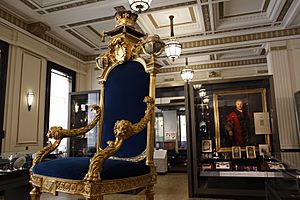Museum of Freemasonry facts for kids
The Museum of Freemasonry is a special place in London, England. It is located inside Freemasons’ Hall. This museum is all about Freemasonry, which is one of the oldest social groups in the world. It's like a club where people learn about good values and help others.
The museum has a huge collection of items. You can see ceremonial objects, jewelry, special clothing, and even old books. These items show the history of English Freemasonry. The museum also has things from other similar groups. It became a fully recognized museum in 2009. Its collection is considered very important for the whole country.
You can visit the Museum of Freemasonry from Monday to Saturday. It is open from 10 AM to 5 PM. The best part is that entry is completely free!
Contents
Museum History
The idea for the museum started a long time ago. In 1838, the United Grand Lodge of England decided to create a place. This place would keep books, old papers, and interesting objects about Freemasonry. They wanted to start a library and museum.
By 1841, the Library and Museum was open. At first, only English Freemasons could visit it. When the current Freemasons’ Hall was built in 1933, it had a special area just for the museum. This was a key part of the building's design.
In the 1980s, the museum started opening its doors to the public. This meant anyone could visit on certain days. In 1996, the Library and Museum became a charity. Most of the items in the museum are on loan from the United Grand Lodge of England. However, new items bought or given since 1996 belong to the museum's charity.
Since 2001, the museum has been making its collection available online. They also started having public exhibitions and events. In 2017, the museum changed its name. It went from the Library and Museum of Freemasonry to simply the Museum of Freemasonry.
The Building
The Museum of Freemasonry is on the first floor of Freemasons' Hall. This grand building is on Great Queen Street in London. It was finished in 1933. The building has a unique style called Art Deco. It is now a protected historical building.
Freemasons' Hall is not just a museum. It also has offices and meeting rooms for Masonic lodges. It is also a popular place for filming movies and TV shows. You might have seen it in films like James Bond or TV series like The Crown.
The Museum of Freemasonry offers free guided tours of the building. These tours let you see the Grand Temple and other special areas. It's a great way to learn more about the building's history. Remember to book in advance if you are with a group.
What You Can Do
Library and Archives
The Museum of Freemasonry has a huge reference library. It also has archives, which are collections of historical documents. These resources can help you learn about family history. You can even research the lives of famous people. There are over 1.7 million names listed in their digital records from 1751 to 1921.
The museum has worked with the University of Sheffield. Together, they put John Lane’s Masonic Records 1717-1894 online. This book lists all the lodges created by English Grand Lodges. It covers the period from 1717 to 1894.
You can also find old Masonic magazines online. The museum has digitized many of these from 1790 to 1900. Titles include The Freemasons’ Quarterly Review and The Freemason.
The library also holds a rare collection of very old books. These books are over 400 years old. They are on loan from the Societas Rosicruciana in Anglia.
Exhibitions
The Museum of Freemasonry often has special exhibitions. These temporary displays focus on different themes. They are open to everyone.
In 2017, the museum opened Three Centuries of English Freemasonry. This exhibition celebrated 300 years since the first Grand Lodge of England was formed. Other recent exhibitions have included:
- Bejewelled: Badges, Brotherhood and Identity (2018–2019)
- Brethren Beyond the Seas (2017–2018)
- Healing Through Kindness (2016–2017)
- Spotlight: Freemasons and Entertainment (2015–2016)
- Treasures of the SRIA
Learning and Exploring
You can explore the museum's collection online. Their website has a free search catalogue. This lets you look up items from home.
The museum also offers free talks and workshops. These events cover topics like Freemasonry and how museums work. The museum takes part in big cultural events too. These include Museums at Night and Open House London.
The Museum of Freemasonry is part of a group called Museum Mile, London. This group includes many museums in the London Borough of Camden.
Famous Freemasons
The Museum of Freemasonry has items that belonged to many famous people. These individuals were also Freemasons. Here are some of them:
- Malcolm Campbell (1885–1948), a British record holder for land and water speed.
- Winston Churchill (1874–1965), a famous British politician and former Prime Minister.
- Alvin Langdon Coburn (1882–1966), an American photographer.
- Wally Hammond (1903–1965), a British cricket player.
- King Edward VII (1841–1910), a British monarch.
- King George IV (1762–1830), another British monarch.
- Rudyard Kipling (1865–1936), a British poet and author.
- Herbert Kitchener, 1st Earl Kitchener (1850–1916), a British Army Field Marshall.
- Alphonse Mucha (1860–1939), a Czech painter and designer.
- Prince Augustus Frederick, The Duke of Sussex (1773–1843), a British royal.
- Theodor Reuss (1855–1923), a German singer and occultist.
- Herbert Sutcliffe (1894–1978), a British cricket player.
- Oscar Wilde (1854–1900), an Irish poet and writer.
- Johan Zoffany (1733–1810), a German painter and engraver.



